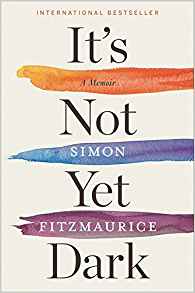
Simon Fitzmaurice, It's Not Yet Dark: A Memoir (New York: Houghton Mifflin Harcourt, 2017), 165pp.
The first thing that Simon Fitzmaurice noticed was how his foot started slapping the pavement, like it was limp or had gone to sleep. That was strange, he thought—the previous year he had done a Himalayan expedition. Perhaps it was his cheap shoes, which he promptly replaced. Later, his arms felt funny when he was painting the bathroom in his house. The day after his wife had a miscarriage, he had some neurological tests, and eventually he started wearing a brace on his foot. Then came the pronounced limp, and the first time he collapsed to the floor.
When the Irish film maker and writer was diagnosed with amyotrophic lateral sclerosis (ALS or Lou Gehrig's disease) in 2008, his doctors told him he had three to four years to live. This memoir was first published in the UK in 2014, and has now been republished in the United States. Fitzmaurice died on October 26, 2017 at the age of forty-three.
This memoir, which was made into a documentary movie of the same title, describes his life in what he calls his Before and After. On the one hand, "ALS takes and keeps taking." His voice was reduced to a slurred whisper. He could only breathe with a ventilator. Completely paralyzed, he was bound to a wheel chair. He availed himself of most every and any type of help—doctors, healers, clergy, books, a psychiatrist, a psychotherapist, six months in Australia, and the Japanese alternative medicine called reiki. All these efforts, he writes, did nothing to halt the progression of the disease: "It progresses, does its own thing, works on its own timeline."
Nonetheless, this is one of the most life-affirming books you will ever read. With the help of an eye-tracking computer, Fitzmaurice lived and worked for nine years after his diagnosis. He loved his wife Ruth and their five kids. He loved his friends and family. He went to the opera. In short, he loved life. He repudiated the least vestige of self-pity. There were very tough times, like a four-month stay in the hospital. But there were also luminous moments when he was "truly happy," full of gratitude, and when his "soul was shining."
This book reminded me of two similar memoirs: Randy Pausch, The Last Lecture(2008), which chronicles what Pausch learned about life after his terminal diagnosis of metastatic pancreatic cancer at the age of forty-six. Never give up. Live for today. There's power in humility. Don't sweat the small stuff. Complaining never helps. Show gratitude. And then, Jean-Dominique Bauby, The Diving Bell and the Butterfly (1997). At age forty-three, Bauby was the editor of Elle magazine, cynical, and a stranger to failure. Then he had a massive stroke that left him in a coma for three weeks. When he awoke, he suffered from a rare neurological disorder called "locked in syndrome." He could hear a little and his brain worked fine, but he was totally paralyzed and couldn't speak. He could blink with his left eye. With his one good eye Bauby dictated his remarkable memoir, letter by letter, to his amanuensis. A speech therapist devised a chart with the letters of the alphabet arranged by frequency of use. As she spoke the letters Bauby would blink for the letter he wanted. Though locked in the heavy "diving bell" of his useless body, Bauby's imagination soared as playfully as "the butterflies that flutter inside my head."


